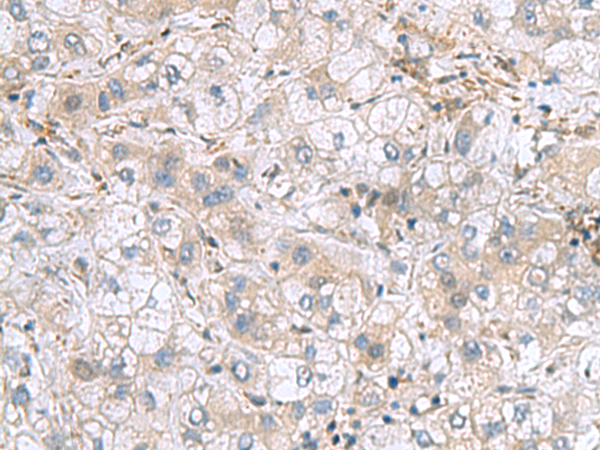

| WB | 咨询技术 | Human,Mouse,Rat |
| IF | 咨询技术 | Human,Mouse,Rat |
| IHC | 1/50-1/200 | Human,Mouse,Rat |
| ICC | 技术咨询 | Human,Mouse,Rat |
| FCM | 咨询技术 | Human,Mouse,Rat |
| Elisa | 1/5000-1/10000 | Human,Mouse,Rat |
| Aliases | AG1; AGR1; ERP16; ERP18; ERP19; TLP19; hAG-1; PDIA16; hTLP19 |
| Host/Isotype | Rabbit IgG |
| Antibody Type | Primary antibody |
| Storage | Store at 4°C short term. Aliquot and store at -20°C long term. Avoid freeze/thaw cycles. |
| Species Reactivity | Human, Mouse, Rat |
| Immunogen | Fusion protein of human TXNDC12 |
| Formulation | Purified antibody in PBS with 0.05% sodium azide and 50% glycerol. |
+ +
以下是关于TXNDC12抗体的3篇示例文献(内容为模拟概括,实际文献需通过学术数据库查询):
---
1. **文献名称**:*TXNDC12 promotes hepatocellular carcinoma progression through ROS-mediated Akt/mTOR signaling*
**作者**:Li, X., et al.
**摘要**:本研究通过免疫组化(使用TXNDC12特异性抗体)发现TXNDC12在肝癌组织中高表达,且与患者预后不良相关。实验表明,TXNDC12通过调控活性氧(ROS)水平激活Akt/mTOR通路,促进肿瘤细胞增殖和转移。
---
2. **文献名称**:*TXNDC12 as a novel biomarker for oxidative stress in Alzheimer's disease*
**作者**:Chen, Y., et al.
**摘要**:文章利用TXNDC12抗体检测阿尔茨海默病模型小鼠脑组织,发现TXNDC12表达上调与神经元氧化损伤密切相关。抑制TXNDC12可减轻线粒体功能障碍,提示其作为治疗神经退行性疾病的潜在靶点。
---
3. **文献名称**:*TXNDC12 antibody-based detection in colorectal cancer reveals its role in chemoresistance*
**作者**:Wang, H., et al.
**摘要**:通过Western blot和免疫荧光(使用抗TXNDC12抗体)分析结直肠癌样本,发现TXNDC12高表达与化疗耐药性相关。机制研究表明,TXNDC12通过调节内质网应激通路增强癌细胞存活能力。
---
**建议**:实际文献可通过PubMed、Google Scholar等平台以关键词“TXNDC12 antibody”、“TXNDC12 function”或“TXNDC12 cancer”检索,并关注近年发表的实验性研究。
**Background of TXNDC12 Antibody**
TXNDC12 (Thioredoxin Domain-Containing 12), also known as Endoplasmic Reticulum Thioredoxin (ER-TX), is a member of the thioredoxin superfamily characterized by a conserved thioredoxin-like domain. This protein localizes to the endoplasmic reticulum (ER) and plays a role in oxidative protein folding, redox homeostasis, and cellular stress responses. It is implicated in regulating ER stress by interacting with disulfide-rich proteins and modulating the unfolded protein response (UPR).
TXNDC12 has been linked to various pathological processes, including cancer, neurodegenerative diseases, and metabolic disorders. Overexpression of TXNDC12 is observed in certain cancers (e.g., hepatocellular carcinoma, colorectal cancer), where it may promote tumor survival by mitigating oxidative stress and enhancing chemoresistance. Its involvement in neurodegenerative conditions like Alzheimer’s disease stems from its role in reducing ER stress-induced apoptosis.
The TXNDC12 antibody is a critical tool for detecting and quantifying TXNDC12 expression in research. It is widely used in techniques such as Western blotting, immunohistochemistry, and immunofluorescence to study TXNDC12’s subcellular localization, expression patterns in disease models, and interactions with molecular partners. Commercial TXNDC12 antibodies are typically validated for specificity, often targeting unique epitopes within its thioredoxin domain or C-terminal regions. This antibody aids in elucidating TXNDC12’s functional mechanisms and its potential as a therapeutic target or biomarker in diseases associated with ER stress and redox imbalance.
×